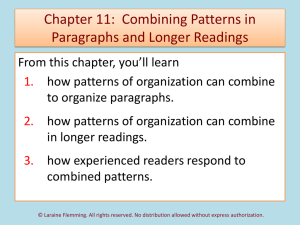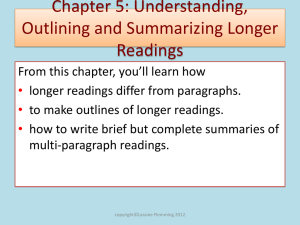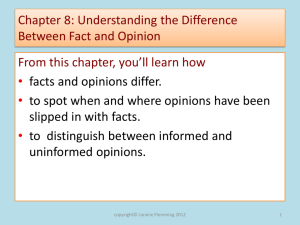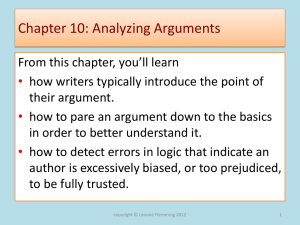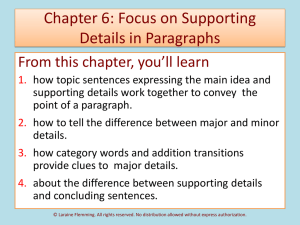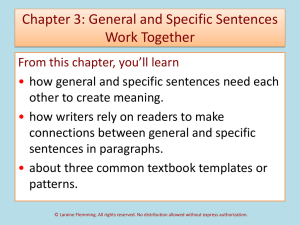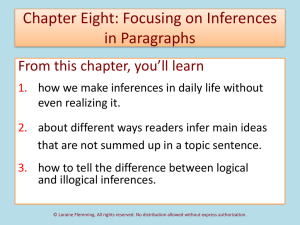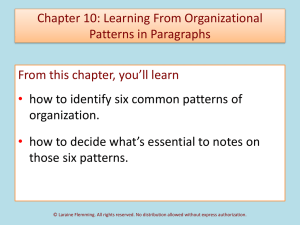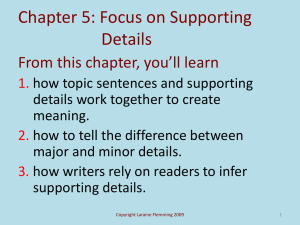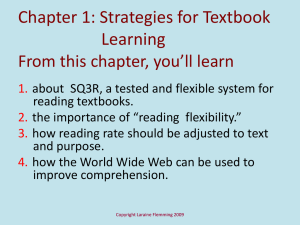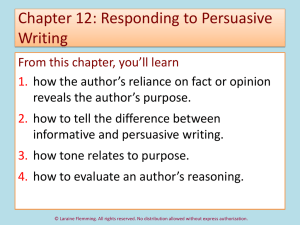Chapter 9: Understanding the Role of Inferences in Longer Readings
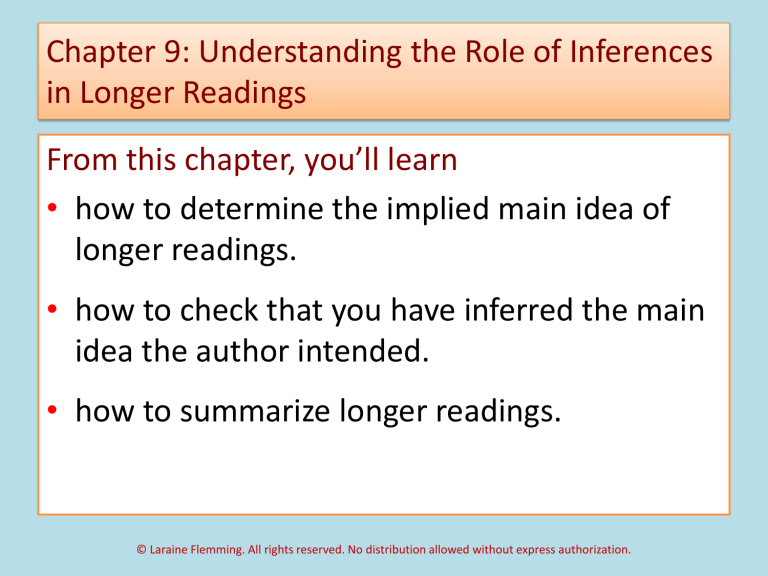
Chapter 9: Understanding the Role of Inferences in Longer Readings
From this chapter, you’ll learn
• how to determine the implied main idea of longer readings.
• how to check that you have inferred the main idea the author intended.
• how to summarize longer readings.
© Laraine Flemming. All rights reserved. No distribution allowed without express authorization.
When the Thesis Statement Goes
Missing
When you can’t seem to find a general statement that sums up the specific details and gets further developed paragraph by paragraph, start asking yourself this question:
When combined, what do the examples, studies, statistics, quotations, etc., in this reading suggest about the topic under discussion?
© Laraine Flemming. All rights reserved. No distribution allowed without express authorization.
Here’s the opening paragraph of a five-paragraph reading. What do you think is the topic? Is there one sentence that refers to the topic and is general enough to be the thesis statement?
• Looking to the Stars for Answers
Astrologers claim they can tell about a person’s past and present from studying the alignment of the planets and stars at the moment of birth. They have made this claim for centuries, starting with the ancient
Babylonians who gave astrology its start. Yet, however ancient the practice of astrology, is it reasonable to believe that the placement of the stars at the time and place of your birth controls your destiny?
© Laraine Flemming. All rights reserved. No distribution allowed without express authorization.
Is there a thesis statement in the second paragraph that answers the question that ends paragraph 1?
Saint Augustine, one of the leaders of the early
Roman Catholic Church, realized that if the stars really determined our fate, then two people born at the exact same time and in the same place should lead the exact same lives. When Augustine found two men living in the same city and born at exactly the same moment, he discovered they were as different as night from day. One was an aristocrat, the other a slave. As a result of his discovery, he abandoned all faith in astrology.
© Laraine Flemming. All rights reserved. No distribution allowed without express authorization.
Is there a thesis statement in the third paragraph?
In more modern times, a great deal of research has been carried out in an effort to verify the claims of astrologers.
In one study published in Nature, the physicist Sean
Carlson provided thirty well-known American and
European astrologists with information about the alignment of the stars and planets for the birth of 116 people. Carlson also gave the astrologers personality profiles for those same people. The astrologers claimed they would be able to match the birth information with the personality profiles over 50 percent of the time. They ended up making a match only 34 percent of the time, which is about as good as someone guessing would do.
© Laraine Flemming. All rights reserved. No distribution allowed without express authorization.
At this point, what do you think is the overall main idea?
Does this paragraph confirm your prediction?
In addition to a failing grade when tested, astrologers also don’t take into account the influence of genetic inheritance or the effect of our environment on later behavior. All the tissues of our body are manufactured according to the information in our genes, and many of the diseases we can fall prey to are more a result of our genes than the stars.
Similarly, studies have repeatedly shown that our upbringing plays a huge role in the personalities we develop, making family and peers more influential than the placement of the planets.
© Laraine Flemming. All rights reserved. No distribution allowed without express authorization.
Is there a thesis statement in this final paragraph?
Decade after decade, polls show that people continue to believe in astrology despite all evidence to the contrary. The question is why? One answer comes from a letter written in
1975 by a band of scientists, who published a letter alerting the public to the fact that astrology had no basis in fact.
Their comments may be as relevant today as they were then:
“In these uncertain times, many long for the comfort of having guidance in making decisions. They would like to believe in astral forces beyond their control. However, we must all face the world, and we must realize that our futures lie in ourselves, and not in the stars.”
(Theodore Schick and Lewis
Vaughn, How to Think About Weird Things, McGraw Hill, 2002, p. 128.)
© Laraine Flemming. All rights reserved. No distribution allowed without express authorization.
What to do when no thesis statement turns up even at the very end of a reading?
Once you finish a reading and realize you have a sense of what it’s about but have found no general statement summing it up, it’s time to
1.
identify the key points made in the reading.
2.
come up with a statement that sums them up in a general way.
What are the key points made in this reading?
© Laraine Flemming. All rights reserved. No distribution allowed without express authorization.
There are three points made repeatedly, and as always, repetition is a clue to importance.
1.
There is no solid evidence suggesting that the alignment of the stars and planets at the moment of our birth decides our fate.
2.
There is evidence suggesting that astrological predictions are no better than guessing.
3.
Despite evidence to the contrary, many people continue to believe in astrology.
© Laraine Flemming. All rights reserved. No distribution allowed without express authorization.
Which statement sums up all three points?
• Although there is scant evidence proving that what happens to us in life depends on how the stars and planets were aligned at our birth, people all over the world believe in astrology.
• Scientists have tried over the decades to convince people that astrology is not a science. However, believers just will not listen.
• Although there is evidence that astrology is not based on any scientific proof, people continue to believe in it because they don’t want to feel that life is solely in their own hands.
© Laraine Flemming. All rights reserved. No distribution allowed without express authorization.
When the chapter section or essay you’re reading doesn’t supply you with a thesis statement,
1.
Consider what ideas are repeated or referred to throughout the reading.
2.
Think about their relationship to one another.
3.
Come up with a statement that generally summarizes both the ideas and their relationship.
4.
Check your inferred main idea against the content of the supporting details.
5.
If the supporting details seem to flesh out or further explain the idea you inferred, you’ve made the right choice.
© Laraine Flemming. All rights reserved. No distribution allowed without express authorization.
Summarizing What you Read
Summaries
1.
are brief, more condensed versions of the original.
2.
start with the main idea.
3.
record only those details that are absolutely essential to explaining or proving the main idea.
4.
eliminate introductory material, colorful anecdotes, repetition for emphasis, and obvious examples.
5.
identify the writer’s point of view without inserting yours.
6.
use your language rather than copying the authors.
7.
change their content somewhat depending on your purpose
© Laraine Flemming. All rights reserved. No distribution allowed without express authorization.
Summary and Purpose 1
If you are writing a summary for an assignment, your summary should open like this: “Guy
Winch, writing in the Internet magazine Salon, points out that brain scans show how powerfully humans react to rejection. Scans show that the brain reacts as if experiencing a physical wound.”
© Laraine Flemming. All rights reserved. No distribution allowed without express authorization.
Summary and Purpose 2
If you are summarizing for reading notes, identifying the source is less important. Instead, for test-taking purposes, you may want a little more supporting detail, for example:
“Brain scans indicate how powerfully humans react to rejection. In classic study, the person left out of a ball toss reacted to exclusion as if it were a physical wound and taking Tylenol appeared to lessen the emotional blow.”
© Laraine Flemming. All rights reserved. No distribution allowed without express authorization.
When you are thinking about what to eliminate from the original text in order to write a summary, consider questions like these:
1.
Is there any introductory material I can eliminate?
2.
How can I sum up the main idea?
3.
How many supporting details do I need to make the main idea clear? Which ones can I cut without making the author’s point unclear?
4.
Is there anything the reader would know without being told? What background knowledge can I take for granted?
5.
Is any idea repeated for emphasis?
© Laraine Flemming. All rights reserved. No distribution allowed without express authorization.
Different texts produce different answers. But depending on the material, complete summaries answer questions like these:
1. Who did what? Why did they do it? And what were the causes and the consequences of this action?
2. What event took place? Why was it considered significant? What happened as a result?
3. What new discovery, research or study is discussed?
How does it change the way we view the world?
What set of questions would fit the text that follows?
© Laraine Flemming. All rights reserved. No distribution allowed without express authorization.
Here’s the original. Read it and consider what information from each sentence you would keep or cut.
1 In an article in the New York Times titled “Why Are We Drugging Our
Soldiers?” Professor Richard A. Friedman, a professor of psychiatry at
Weill Cornell Medical College, has pointed to the steady increase in post-traumatic stress syndrome (PTSD) among soldiers who served in the wars taking place in Afghanistan and Iraq. 2 Although PTSD is known to be caused by prolonged exposure to dangerous combat environments, Friedman believes there is another factor in play: the military’s increased use of medical stimulants such as Ritalin and
Adderall to help soldiers stay alert for long hours. 3 As proof of his claim, he points to the massive increase in prescriptions written for the two drugs. 4 Over five years, military prescriptions climbed from 3,000 to
32,000. 5 The stimulants are known to strengthen learning and memory formation. 6 Thus they could contribute to the vivid flashback memories that plague victims of PTSD. 7 In effect, the stimulants might make the horrors or war unforgettable.
© Laraine Flemming. All rights reserved. No distribution allowed without express authorization.
Here’s one way to summarize the reading:
1 In the New York Times article, “Why Are We Drugging
Our Soldiers?” psychiatry professor Richard A.
Friedman argues that the rising rates of Post-Traumatic
Stress Syndrome (PTSD) can be traced to more than the experience of combat. 2 In addition to the brutal effects of war, Friedman points to the military’s increased use of drugs such as Ritalin and Adderall to help soldiers stay alert for long periods of time. 3 Because the drugs strengthen memory formation, Friedman believes they may encourage the flashbacks to combat that are typical of PTSD.
© Laraine Flemming. All rights reserved. No distribution allowed without express authorization.
Summary Check List
No two people would write the same summary but a summary does its job
1.
if it answers the general questions raised by the original text.
2.
if it eliminates anything not absolutely central to understanding the main idea.
3.
if it allows a reader who never read the original to understand the overall point along with the reasons, studies, figures, examples, etc., used to explain it.
© Laraine Flemming. All rights reserved. No distribution allowed without express authorization.
A Word to the Wise
Writers answer the questions they assume their readers might raise. When you write a summary, determine which questions the author of the original text wanted to answer.
Then, in abbreviated form, answer those same questions in your summary.
© Laraine Flemming. All rights reserved. No distribution allowed without express authorization.
Finishing Up: Understanding the Role of
Inferences in Longer Readings
You’ve previewed the major concepts and skills introduced in
Chapter 9. Take this quick quiz to test your mastery of those skills and concepts, and you are ready to read the chapter.
© Laraine Flemming. All rights reserved. No distribution allowed without express authorization.
Finishing Up: Understanding the Role of Inferences in Longer Readings
1.
If you are reading a chapter section or an article and aren’t finding a general statement that seems to sum up the specific details, what question should you start thinking about answering?
2.
As with readings that state the main idea, what’s a key clue to importance in readings that imply the main idea?
© Laraine Flemming. All rights reserved. No distribution allowed without express authorization.
Finishing Up: Understanding the Role of Inferences in Longer Readings
3. Once you have inferred what you think is the main idea of the reading, what should you do?
4. How do you know if the main idea you inferred is the same as the author’s implied main idea?
5. True or False. Good summaries always answer the same questions about the topic discussed.
6. True or False. Your purpose should not affect the content of your summary.
7. True or False. One way to write a summary is to select different sentences from the original text and combine them.
© Laraine Flemming. All rights reserved. No distribution allowed without express authorization.
Brain Teaser Challenge: Can you infer a main idea that links together the people described here? a . Abraham Lincoln sometimes wept in public. He told jokes because he claimed only laughter could keep him from despair.
Those who knew him well knew he was plagued by what the nineteenth century called “melancholy” and what we would call clinical depression. b. The poet Anne Sexton suffered from depression and channeled her misery into poems like “The Black Art,” where she complained that “a woman who writes feels too much.” For
Sexton, the first onset of depression followed the birth of her daughter in 1954. Twenty years later, Sexton killed herself by sitting in her car and inhaling carbon monoxide.
© Laraine Flemming. All rights reserved. No distribution allowed without express authorization.
c . Winston Churchill, Britain’s prime minister during World War
II, was known for his sharp wit. But he was also known for his dark moods, and Churchill himself wrote about suffering from the “black dog” of depression. d . Mark Roget, the man who created Roget’s Thesaurus, suffered from prolonged states of depression. Roget was fortunate, though. He discovered that compiling lists of words could make him forget his mental misery. In the end, Roget’s cure for the blues was a gift to all language lovers.
What main idea ties all four of these descriptions together?
© Laraine Flemming. All rights reserved. No distribution allowed without express authorization.
